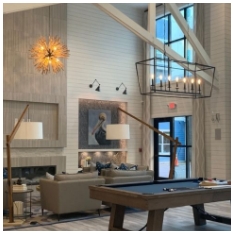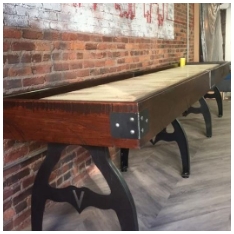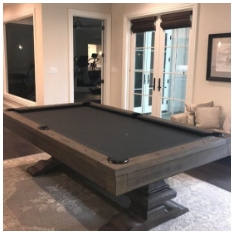When choosing a shuffleboard table, understanding the materials and finishes is essential. Each material and finish affects the table's appearance, durability, and playing experience. In this guide, we will compare the best materials and finishes for shuffleboard tables to help you make an informed decision. We'll also explore how these factors relate to other gaming tables, like pool tables, to provide a comprehensive overview.

Understanding Shuffleboard Table Materials
The material used in the construction of a shuffleboard table directly impacts its longevity and performance. Below, we’ll explore the most common materials and their pros and cons.
Solid Wood
Solid wood is a traditional and popular choice for shuffleboard tables. Often made from maple, walnut, or oak, solid wood offers durability and a classic look. Maple, in particular, is favored for its hardness and smooth finish, which contributes to a consistent playing surface. The natural grain of wood gives each table a unique aesthetic, adding warmth to any room.
However, solid wood is susceptible to changes in humidity and temperature, which can cause warping or cracking over time. Proper care, including regular waxing and maintaining a stable environment, is necessary to preserve the table's condition.
Engineered Wood
Engineered wood, such as plywood or MDF (medium-density fiberboard), is a more affordable alternative to solid wood. It consists of layers of wood veneers glued together, making it resistant to warping and cracking. While it may not have the same premium feel as solid wood, engineered wood offers good stability and is often used in the base or frame of shuffleboard tables.
The main drawback is that engineered wood doesn't have the same natural beauty as solid wood. However, it can be finished with veneers that mimic the appearance of higher-end materials, providing a similar aesthetic at a lower cost.
Polymer Playing Surface
Modern shuffleboard tables often feature a polymer playing surface. This durable synthetic material is applied over the wood, providing a smooth and consistent glide for the pucks. The polymer surface also protects the underlying wood from damage, reducing the need for maintenance.
Polymer surfaces are highly resistant to scratches, dents, and moisture, making them ideal for heavy use. They are easy to clean and maintain, ensuring the table stays in top condition for years. While some purists may prefer the feel of a traditional wood surface, polymer surfaces offer superior performance and longevity.
Exploring Shuffleboard Table Finishes
The finish on a shuffleboard table is not just about aesthetics; it also plays a crucial role in the table's performance and durability. Here, we'll compare the most common finishes used on shuffleboard tables.
Traditional Varnish
Traditional varnish is a popular finish for shuffleboard tables. It enhances the wood's natural beauty, giving it a glossy appearance that highlights the grain. Varnish also provides a protective layer that shields the wood from minor scratches and spills.
While varnish offers a classic look, it requires regular maintenance to keep the surface smooth. Over time, varnish can wear down, especially in high-use areas, leading to uneven play. Reapplication is necessary to maintain the table's performance and appearance.
Polyurethane Finish
Polyurethane is a more durable alternative to varnish, providing a tough, long-lasting finish that resists scratches and moisture. It is available in both water-based and oil-based formulas, each offering different benefits.
Water-based polyurethane dries quickly and has low odor, making it a convenient option for home use. It provides a clear finish that won't yellow over time, preserving the table's original color. Oil-based polyurethane, on the other hand, offers a richer finish that enhances the wood's depth and warmth, though it takes longer to dry and has a stronger odor.
Polyurethane finishes are ideal for players who want a low-maintenance table that can withstand heavy use. They are also easier to clean than varnish, requiring only a damp cloth to remove dust and debris.
Polymer Coating
Polymer coating is often used in conjunction with a polymer playing surface. This finish is applied as a thick layer over the table, creating a glass-like surface that is incredibly smooth and durable. Polymer coatings are highly resistant to scratches, dents, and moisture, making them one of the most durable finishes available.
The main advantage of a polymer coating is its low maintenance. Unlike varnish or polyurethane, polymer coatings do not require regular reapplication. They are also resistant to UV rays, preventing the surface from fading or discoloring over time.
Comparing Shuffleboard Tables with Pool Tables
When selecting a shuffleboard table, it's helpful to compare it with another popular game table: the pool table. Both types of tables are centerpieces in game rooms and require careful consideration of materials and finishes.
Durability and Maintenance
Both shuffleboard and pool tables require durable materials to withstand regular use. Solid wood is a common material in both, though pool tables also use slate for the playing surface, which is highly durable and resistant to warping. Shuffleboard tables often use polymer coatings for added durability, while pool tables rely on felt and slate for a smooth playing experience.
In terms of maintenance, both types of tables require regular care to keep them in good condition. Shuffleboard tables need waxing to ensure a smooth glide, while pool tables require regular brushing and re-leveling to maintain the playing surface.
Aesthetics and Design
Aesthetically, both shuffleboard and pool tables can serve as focal points in a room. Solid wood and high-quality finishes are often used in both, offering a luxurious look that complements various interior styles. Shuffleboard tables with a polymer surface may have a more modern appearance, while traditional wood finishes provide a classic look.
Pool tables often come in a wider variety of designs, from classic to contemporary, allowing them to fit seamlessly into different room decors. Shuffleboard tables, while available in various styles, typically lean towards a more traditional design.
Choosing the Right Shuffleboard Table for Your Space
Selecting the perfect shuffleboard table involves considering several factors, including the materials, finishes, and how it compares to other gaming tables like pool tables. Here’s a summary to help you make the best choice:
- Consider the Room Size: Shuffleboard tables come in various lengths, typically ranging from 9 to 22 feet. Ensure you have enough space not only for the table but also for players to move around comfortably.
- Prioritize Durability: If you expect heavy use, opt for tables with polymer playing surfaces and coatings. These offer the best protection against wear and tear.
- Match Your Aesthetic: Choose a table that complements your room’s design. Solid wood tables with traditional finishes offer a timeless look, while polymer surfaces and modern designs suit contemporary spaces.
- Think About Maintenance: Consider how much time you’re willing to spend on upkeep. Polymer-coated tables require less maintenance, while traditional varnish finishes may need regular reapplication.
- Compare with Other Gaming Tables: If you already have a pool table, think about how the shuffleboard table will complement it. Matching materials and finishes can create a cohesive look in your game room.
Conclusion
Selecting the right shuffleboard table involves understanding the materials and finishes that impact its durability, performance, and aesthetic appeal. Whether you prefer the classic look of solid wood with a varnish finish or the durability of a polymer-coated surface, the key is to choose a table that fits your needs and style. Comparing shuffleboard tables with pool tables can also provide additional insights, helping you create a cohesive and enjoyable game room. By considering these factors, you can find the perfect shuffleboard table that will provide years of entertainment and enhance your space.





